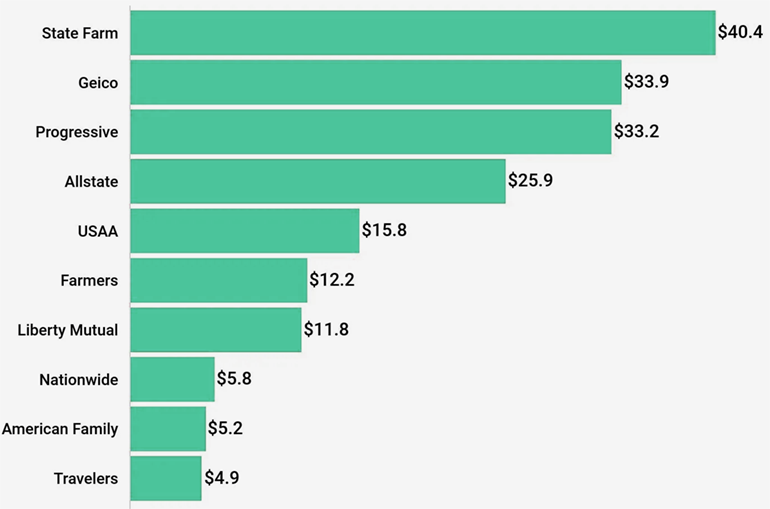Introduction
Insurance companies play a significant role in providing financial protection and risk management solutions to individuals, businesses, and organizations worldwide. In this informative guide, we’ll take a closer look at the top 10 biggest insurance companies, examining their market dominance, financial strength, range of products, and the impact they have on the insurance industry as a whole. Whether you’re seeking insurance coverage or interested in understanding the dynamics of the insurance market, this guide will offer valuable insights into the leading players in the industry.
Introduction to the Insurance Industry
Before delving into the top 10 insurance companies, it’s essential to understand the broader insurance industry’s significance. Insurance serves as a mechanism for transferring risk from individuals or businesses to insurance companies in exchange for premium payments. By pooling resources and spreading risk across a diverse portfolio of policyholders, insurance companies help mitigate the financial impact of unforeseen events such as accidents, natural disasters, or liability claims.
Criteria for Ranking Insurance Companies
The ranking of insurance companies is typically based on various factors, including:
Total Assets: The value of assets held by the insurance company, including investments, reserves, and property.
Premiums Written: The total amount of premiums collected by the insurance company for policies issued during a specific period.
Market Capitalization: The total market value of the insurance company’s outstanding shares of stock.
Financial Strength Ratings: Assessments of the insurer’s financial stability and ability to meet its obligations to policyholders.
Customer Satisfaction: Ratings and reviews from policyholders and industry experts regarding customer service, claims handling, and overall satisfaction.
Overview of the Top 10 Biggest Insurance Companies
Company A:
Brief description of the company, including its founding year, headquarters location, and primary lines of business. Highlight notable achievements, such as market leadership, innovative products, or recent expansions.
Company B:
Provide similar information for the second-largest insurance company, highlighting key attributes and distinguishing features that contribute to its industry prominence.
Company C:
Repeat the process for each of the remaining companies in the top 10 list, providing insights into their operations, market positioning, and strategic initiatives.
Factors Contributing to Their Success
The top 10 insurance companies have achieved their status through a combination of factors, including:
Strong Financial Performance:
Demonstrated by robust balance sheets, steady revenue growth, and prudent risk management practices.
Diversified Product Portfolio:
Offering a broad range of insurance products and services tailored to meet the diverse needs of consumers and businesses.
Extensive Distribution Channels:
Utilizing multiple distribution channels, including agents, brokers, online platforms, and strategic partnerships to reach customers effectively.
Brand Reputation:
Building trust and credibility through consistent delivery of quality service, prompt claims processing, and proactive risk management solutions.
Innovation and Adaptability:
Embracing technological advancements, data analytics, and market trends to drive innovation, improve operational efficiency, and enhance customer experiences.
Impact on the Insurance Industry
The top 10 insurance companies exert significant influence on the insurance industry’s dynamics, including:
Market Leadership: Setting industry standards and shaping competitive trends through their size, scale, and market share.
Regulatory Compliance: Adhering to regulatory requirements and industry standards to maintain credibility and protect policyholder interests.
Mergers and Acquisitions: Engaging in strategic mergers, acquisitions, and partnerships to expand market reach, diversify product offerings, and achieve economies of scale.
Global Presence: Operating on a global scale, with presence in multiple countries and regions, contributing to market stability and resilience.
FAQs (Frequently Asked Questions)
What factors determine the ranking of insurance companies?
The ranking of insurance companies is typically based on factors such as total assets, premiums written, market capitalization, financial strength ratings, and customer satisfaction scores.
How do insurance companies assess financial strength?
Insurance companies assess their financial strength through various measures, including capital adequacy ratios, solvency margins, investment portfolios, and credit ratings from independent rating agencies such as Standard & Poor’s, Moody’s, and A.M. Best.
What types of insurance products do the top 10 insurance companies offer?
The top 10 insurance companies offer a wide range of insurance products, including life insurance, health insurance, property and casualty insurance, auto insurance, commercial insurance, and specialty lines such as reinsurance and annuities.
How do insurance companies compete with each other?
Insurance companies compete with each other by offering competitive pricing, innovative product features, superior customer service, expansive distribution networks, and effective marketing strategies to attract and retain policyholders.
What role do insurance companies play in the global economy?
Insurance companies play a crucial role in the global economy by providing financial protection, promoting risk management, facilitating investments, supporting economic growth, and contributing to financial stability and resilience in the face of uncertainties.
Conclusion
In conclusion, the top 10 biggest insurance companies play a pivotal role in the insurance industry, serving as pillars of strength and stability in an ever-evolving landscape. Their market dominance, financial strength, and commitment to innovation underscore their importance as key players shaping the future of insurance. As consumers and businesses navigate the complexities of insurance coverage, understanding the strengths and capabilities of these industry leaders is essential for making informed decisions and securing reliable protection against life’s uncertainties.


